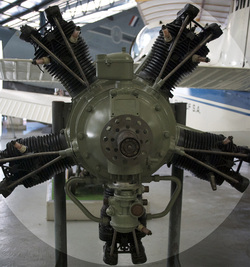Armstrong Siddeley Genet
 Click on image for larger version
Click on image for larger version The British Armstrong Siddeley company was formed in 1919 to initially manufacture top end motor vehicles and later aircraft engines. In 1926 the Armstrong Siddeley 'Genet' was designed as a five cylinder air cooled radial piston engine with a power output of 88hp. It rapidly proved popular with aircraft constructors due to its demonstrated reliability and was used to power many light aircraft prior to WW2 including the Avro Avian, DH 60 Gipsy Moth, Cierva autogyros, Junkers Junior and Westland Widgeon, to name a few.
Design of other five and seven cylinder radial piston engines followed, all named after 'Cats'. Siddeley was taken over by the Hawker Aircraft Company to form Hawker Siddeley in 1935, and in 1960 their aircraft engine division was merged with Bristol Aero Engines to become Bristol Siddeley that was in turn taken over by Rolls Royce in 1966.
In 1934 Captain Bremer piloted his Genet-powered Junkers Junior in a 22-country around-the- world flight, with the exception of the Atlantic and Pacific Ocean crossings, when it was transported by ship.
Design of other five and seven cylinder radial piston engines followed, all named after 'Cats'. Siddeley was taken over by the Hawker Aircraft Company to form Hawker Siddeley in 1935, and in 1960 their aircraft engine division was merged with Bristol Aero Engines to become Bristol Siddeley that was in turn taken over by Rolls Royce in 1966.
In 1934 Captain Bremer piloted his Genet-powered Junkers Junior in a 22-country around-the- world flight, with the exception of the Atlantic and Pacific Ocean crossings, when it was transported by ship.
|
TECHNICAL DATA
Cylinders Bore x Stroke Displacement Length Diameter Dry weight Valve system Maximum Power Power to weight ratio |
Five cylinder, air cooled radial, direct drive engine 4 in (101.5 x 101.6 mm) 251.43 cubic inches (4.3 litres) 28.5in (724mm) 34in (863mm) 203lbs (90kg) 1 inlet and 1 exhaust popet valve per cylinder 88HP @ 2,200 RPM 0.39hp/lb |
